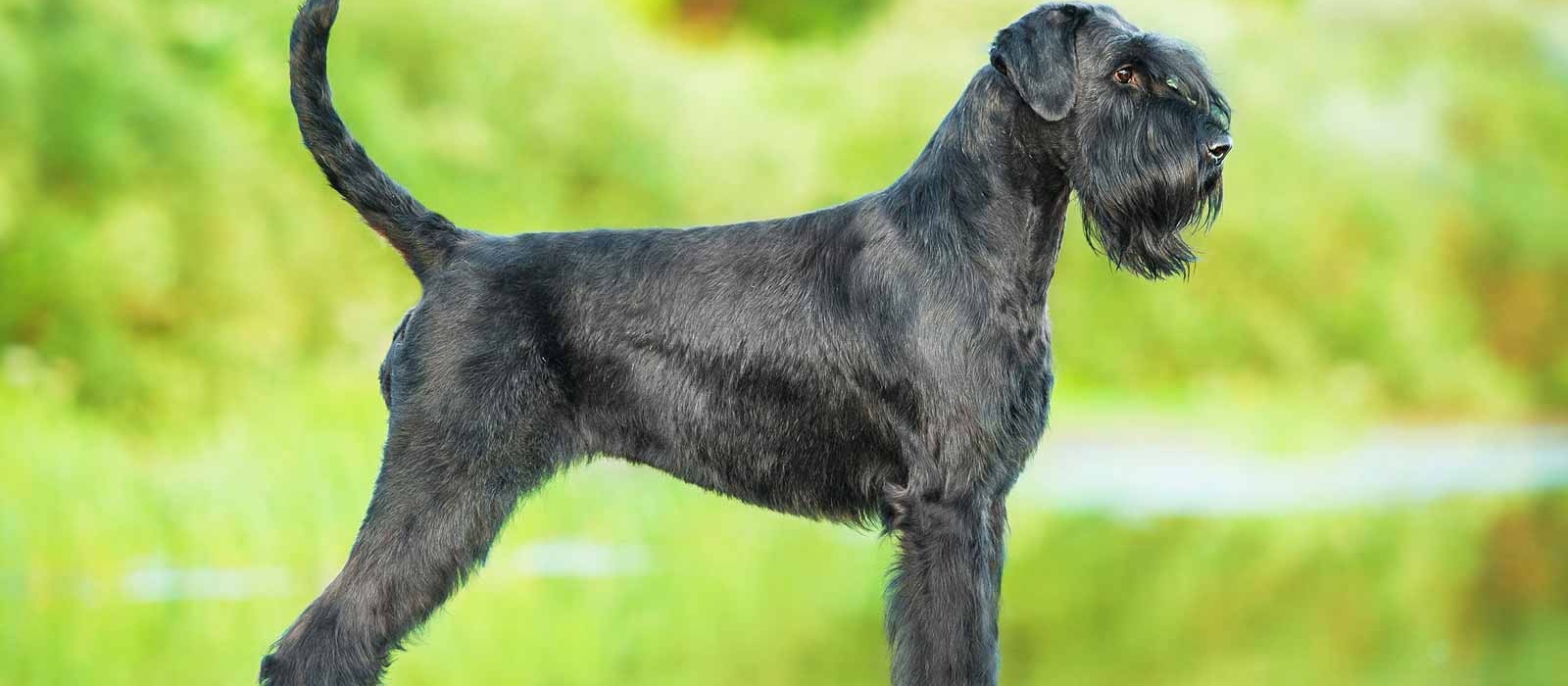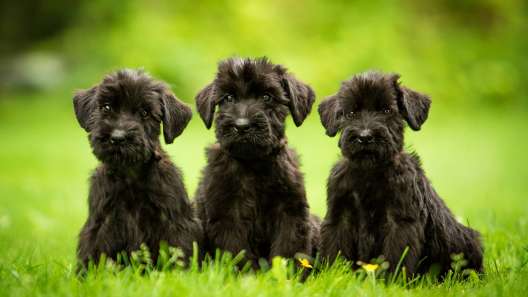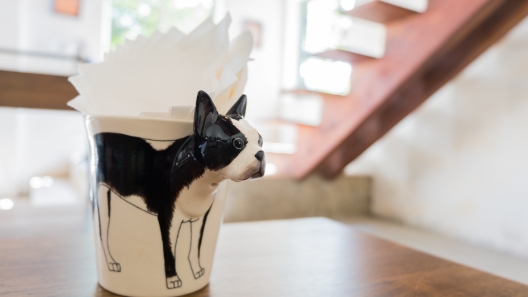-
Activity Level:
high
-
Shedding Level:
low
-
Grooming Level:
high
-
Trainability:
moderate
-
Good for Novice Owners:
moderate
-
Adaptability:
moderate
-
Kid/Pet Friendly:
often
-
Prey Drive:
high
-
Watchdog:
very alert
- Average Size: Large
- Average Lifespan: 10-13 years
- Registered?: aca, akc
Giant Schnauzer Dog Breed Information
Overview
Temperament
Adaptability
Health
Owner Experience
Grooming
Activity Level
Size
Life Span
Did You Know?
The Giant Schnauzer originated in Germany during the mid-17th century, more specifically, in the Bavarian Alps. One of the facts about Schnauzers is that there are three breeds of Schnauzer – Miniature, Standard, and Giant. Naturally, the Giant Schnauzer is the largest of the three. It was bred up from the Standard Schnauzer in order to create a larger rugged working dog.
Giant Schnauzers were most commonly used as cattle drovers to move cattle from the farm to the market. In addition to driving cattle, these dogs could also be found working as guard dogs. Later, they were a popular choice for work as police dogs throughout Europe and as military dogs during World War I and World War II.
Although they came to the United States during the 1930s, they did not become popular until the 1960s. The Giant Schnauzer stood out as a show dog and could often be found winning obedience competitions. They were also popular as beloved family pets that guarded both the home and their family. The American Kennel Club recognized the Giant Schnauzer in 1930 as a member of the Working Group.
Giant Schnauzers are a generally quiet dog breed outside of alert barking, but they are also energetic and can be high-spirited. They are loyal, courageous, devoted to their families, and get along well with children when they are well-socialized. Due to their guardian background and still being one of the dog breeds that are good guard dogs, they can be territorial and are naturally suspicious of strangers.
This makes socialization and training early and often very important. It’s also not a bad idea to train your dog to stop barking early on. These dogs will bark to alert you and can end up barking a lot if you do not do some training and socialization with them.
The Giant Schnauzer is a moderately adaptable dog breed. Due to their size and their high energy levels, they do not tend to do well in apartments. They are better suited to larger homes with fenced-in yards where they can run.
They do well in cold weather and can tolerate a little heat. As with any dog breed, they are sensitive to extremes and have a higher sensitivity to heat. Because they are so devoted to their families, they do not like to be left alone for long periods of time.
Overall, this is a relatively healthy dog breed. As with all dog breeds, there are some potential health conditions to be aware of. For the Giant Schnauzer, potential health issues could include eye disease, hip dysplasia, and autoimmune thyroiditis.
Responsible breeders will screen their dogs for these issues to avoid passing them on to puppies. So, don’t be afraid to ask the breeder questions about the genetic history of the parents and to see any relevant health clearances or test results. The Giant Schnauzer Club of America, Inc. recommends an elbow evaluation, a hip evaluation, an ophthalmologist evaluation, and a thyroid evaluation.
The Giant Schnauzer is a moderately trainable dog breed. They are highly intelligent, they learn quickly, and they are eager to please. But, they need a job to do to be happy, require a lot of exercise and mental stimulation, and can have a stubborn streak.
These traits can sometimes be difficult for a first-time dog owner to navigate and handle successfully on their own. Obedience and puppy training classes, or the help of a professional trainer, can help a dedicated first-time owner with this dog breed.
The benefits of puppy training classes also go beyond training and into socialization and bonding. So, they are often a good idea even if you don’t necessarily need them for help with training.
The Giant Schnauzer has a weather-resistant double coat. The undercoat is dense and soft while the outer coat is harsh and wiry. Their coat requires weekly brushing and regular bathing, stripping, and clipping to stay healthy. Taking your Giant Schnauzer to a professional groomer you trust can help you handle the stripping and clipping of their coat.
In addition to coat care, you will also need to care for your Giant Schnauzer’s nails, ears, and teeth. Once or twice monthly nail trimming is usually sufficient to keep them from getting too long. Checking ears weekly and carefully cleaning them as needed can help prevent ear infections.
It’s also important to practice good dental care. A dog’s teeth are often overlooked until there is a problem, which is why dental disease is one of the most common health issues in dogs. By implementing proper dental care for dogs, like brushing their teeth or using an enzyme toothpaste every day and getting cleanings at the vet when needed, you can help prevent the tartar and plaque buildup that leads to painful dental diseases like gum disease and tooth decay later in life.
Although not a giant dog breed, the Giant Schnauzer is still a big dog and needs an even bigger amount of exercise to stay happy and healthy. This dog breed needs long daily walks in addition to playtime and extra activity. They are great workout companions and enjoy a wide variety of activities. Just make sure things stay low-impact until puppies finish growing and your vet clears them for higher-impact activities to avoid damaging growing bones and joints.
Your Giant Schnauzer may enjoy running with you, going on a hike, swimming with you, playing fetch, and more. Some Giant Schnauzers have even been known to enjoy accompanying their owners while cycling or cross-country skiing!
More often than not, they will be more than happy to be doing something active with you. These dogs often prefer being active with a companion, whether that’s their favorite human or a dog friend. They also tend to be great candidates for several dog sports, including obedience, agility, herding, coursing, carting, and more.
A fully-grown Giant Schnauzer usually stands 23-28 inches tall at the shoulder and weighs 55-95 pounds. Females tend to average 23.5-25.5 inches tall and weigh 55-80 pounds, while males tend to average 25.5-27.5 inches tall and weigh 75-95 pounds.
Giant Schnauzers generally live for 10-13 years on average.
Although this dog breed is called the “Giant” Schnauzer, they are not a giant dog breed. They’re just larger than the Standard Schnauzer. Also, they may all be called Schnauzers, but Miniature, Standard, and Giant Schnauzers are all distinct dog breeds. They were just bred and developed to have a similar look in differently-sized packages.









